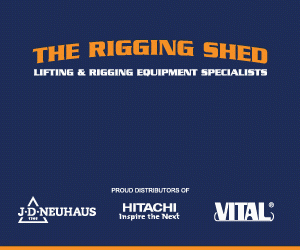)
People Development: Five Golden Rules
In the second part of a mini series about building a team, Ashley Thacker presents five important elements of a successful, long-term people development program.
My last column in Lift & Hoist Australasia (LHA) magazine focussed on recruitment techniques and closed with references to the importance of nurturing talent and helping people grow in line with their skillsets. I’d noted that a common shortcoming of certain companies is a blinkered approach to personal development and staff training. Conversely, good businesses obsess over investment in their workforce.
The article served as a conversation starter so here’s a follow-up that zooms in on the Top 5 components, in my opinion, of a successful people development program:
- Get buy-in from all parties
People development doesn’t work if it isn’t part of a company’s culture.
If it’s only the responsibility of one member of staff to push team members onto courses or remind individuals that they are due a refresher, the full benefit of a properly trained workforce will never be realised. Neither can results be achieved by a supervisor or middle manager swimming against the tide on his or her own. If they’re banging repeatedly on the boss’s door demanding that his or her team need better access to training, it demonstrates that it will likely be viewed as an unnecessary cost. Even if a whole suite of directors or everyone on the shop floor understands the importance of people development, the magic only happens if the commitment is in totality—and from the top down.
As we’ve explored before, great culture isn’t easy to achieve and maintain, and it is only possible through clear leadership and people development that strengthens the connection between staff and the greater company cause.
- Make it infectious
Where people development isn’t part of a company’s culture it can only be seen in certain areas; it’s prevalent in corners but not widespread. It creates a negative environment where people who have achieved skills, knowledge, training or experience, guard it through fear they’ll lose something by passing it on. Actually, as a company’s individuals acquire or attain knowledge, it’s important it is shared within the team and translated into practice. It’s a key component of people development that leadership keeps everyone informed about company advancement through training and those who’ve gained knowledge pass it on.
Of course, where training and standardisation is concerned, only a proper, accredited course in a controlled environment will work, but in terms of a group better understanding rigging tools and how they’ve been applied in the field, there’s much you can achieve in-house with your own development programs.
As a people development-driven culture expands, many members of staff will become trained in multiple roles across a business, which means the company can cover all bases even at busy times—and there’s great job variation. A sales team, for example, might be put through Lifting Equipment Engineers Association (LEEA) courses so people are trained on how to use and inspect the equipment they sell. This adds far more efficiency to sales processes because they can apply an understanding of the equipment’s capabilities and ensure the customer always gets the right tool for the job.
- Leave no stone unturned
Particularly in a niche market, it isn’t always easy to find the right people to train and educate a workforce. It’s not as simple as taking to Google and typing in the requirements, like it might be in some trades or when a person wants to find a local driving instructor. You should be prepared to source coaches and mentors from the world over, not just from a limited geography.
Always work with specialists; again, in diverse markets this is a necessity. When we’re looking to educate staff on subjects like height safety or material handing, only qualified thought leaders can provide depth and breadth of content. Safety and training is big business and there’s a tendency for some providers to become too broad. I’d rather digest information from someone who’s worked in an area his or her whole career than a retired forklift truck driver that has suddenly diversified into mobile crane inspection.
- Accept that people development is a dynamic practice
Yes, training must be given priority in the diary and fixed at regular intervals, yet flexibility is important.
There isn’t a curriculum that can be downloaded that outlines a training pathway a business can take from January to December to bring a workforce up to scratch. It’s got to be overseen by a good quality assurance (QA) team and tailored to the needs of the employees and their skillsets. There’s a lot of redundancy in some company’s training programs, probably because there’s detachment from the content that is required and what is readily available. Rolling out Metalworking Part 1A to an experienced team of welders will have a negative, demotivating impact and will create completely the wrong impression about training.
A regimented program that stretches months or years ahead might not suit staff changes or evolution in industry standards and product development. There’s little to gain in running a Part 2 course for participants who haven’t taken Part 1, on a hoist that’s now obsolete. That’s training for training’s sake; it’s box ticking. Instead, look for knowledge gaps and encourage staff to suggest areas where they feel additional training might be useful, with safety and productivity being the key criteria.
Guard against sticking to a long-term path for an individual. Someone might join the company in one role but start to develop or show an interest in a different area to what either party might have envisaged at the outset. Training should be tailored for an individual not a job title. People learn at different speeds and a flair for something might not emerge until the mid-point of a professional’s career—or even later. Businesses should be happy to reimburse staff for higher education courses and encourage them to explore paths away from their core job functions.
- Prove it works
This one is important.
There will always be sceptics in a company about the value of certain costly initiatives (they might have CFO on their business card!). It’s important therefore that metrics are created to track the progress that can be attributed to people development. Staff retention in itself can represent a huge saving for a business but cynics will want more tangible examples, such as orders that wouldn’t have been won without a certain level of expertise, or major tier one contracts that have been renewed because of performance that can be traced back to training.
By way of a case study, back in 2010, my company was still a small, family business, although we had been trading for 12 years at the time and sales were decent. However, the way we thought about business was not akin to a larger, more corporate business. Whilst we never wanted to lose our family-run ethos and culture—and still don’t—we needed to start to look and act more like a medium to large business. It wasn’t a U-turn, just a re-emphasis on people development.
Remember, customers like dealing with the same people; it gives them a sense of trust knowing that they can rely on folks based on previous dealings. If they are confident those people are also the most dedicated, highly trained professionals in their sector, that leads to even greater peace of mind—and business. A good CFO will get that.
Conclusion
The more companies that invest in training, the better best practices will become, and the safer every job site will be. We should all see ourselves as stakeholders in that endeavour. Don’t subscribe to the fear culture that investment of time and money in enhancing a person’s expertise will be wasted if they leave and give another company the benefit of that experience. It’s a naive way of looking at it because good people don’t leave good businesses or want to walk away from good managers.
Is a poor approach to people development holding you, and your employees, back?









